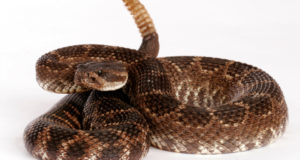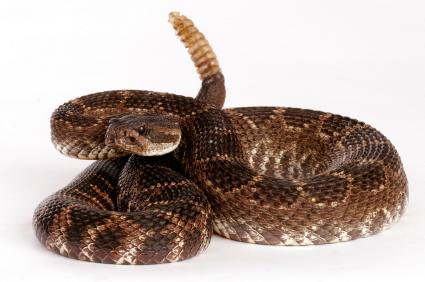 Indiana Jones and I have at least one thing in common: we both hate snakes. While I don’t hate all snakes like Indy, I do have an aversion to being around poisonous ones. There are four types of poisonous snakes in North America, ranging from aggressive to shy.
Indiana Jones and I have at least one thing in common: we both hate snakes. While I don’t hate all snakes like Indy, I do have an aversion to being around poisonous ones. There are four types of poisonous snakes in North America, ranging from aggressive to shy.
Rattlesnake
The most widespread of the poisonous snakes, there are around thirty species of rattlesnake living in the U.S. These snakes range in size from eighteen inches to over seven feet in length. Rattlesnakes are the most aggressive of North America’s poisonous snakes and are characterized by the distinctive rattle at the end of their tails.
Rattlesnakes (along with copperheads and cottonmouths) are pit vipers. These snakes have a heat-sensing pit between their eyes and nostrils to help them locate their prey. Pit vipers can also be recognized by their triangular-shaped head when viewed from above.
Rattlesnake bites can inject a large amount of hemotoxic venom, meaning that it destroys red blood cells and surrounding tissue. Their bites are very serious and can be fatal to humans.
On the other hand, you can bite them back. Rattlesnake makes a good meal. It can be substituted for most other meats. Just cut off the head and skin and remove the entrails (debone if you like). The skins can also be home tanned or sold. I have seen some beautiful bows that were backed with rattlesnake skin. Understand that I don’t recommend seeking out rattlesnakes for these purposes, as you are much more likely to get bitten that way; but if you happen to kill one, there’s no reason to let it go to waste.
Cottonmouth / Water Moccasin
The cottonmouth, also called the water moccasin, is a poisonous snake located primarily in the southeast U.S. They range north to southern Indiana and Illinois and west to Texas. They have an affinity for water and are considered semi-aquatic. Adults average around three feet in length; however they can reach lengths of up to six feet.
When disturbed, the cottonmouth will usually hold its ground and not retreat. Lacking the rattles of a rattlesnake, they will coil up and open their mouths, exposing the white inside as a visual warning. Cottonmouths also have hemotoxic venom, similar to the rattlesnake, although they usually inject slightly less of it with their bite. However, cottonmouth bites tend to become gangrenous if not treated promptly.
Copperhead
Copperheads, so-called because of their coppery coloring, are another pit viper that grows to about three feet in length. Their range is the eastern U.S. up to southern New England and west through Texas. They are the shyest of the pit vipers and have the least potent hemotoxic venom. While all pit vipers are capable of a dry bite (biting without injecting venom), copperheads often give a dry warning bite.
Coral Snake
Coral snakes are a colorful relative of the cobra. They are less than four feet in length and have red, yellow, and black bands. They are also a shy snake that will retreat if given the chance and bite usually as a last resort.
Coral snake venom is a powerful neurotoxin (attacking the nerves and paralyzing), but due to how the snake delivers venom in its bite, it must hang on to pump venom into its victim. This accounts for about 60 percent of coral snake bites being dry bites. But even a small amount of coral snake venom can produce respiratory distress and fatigue for up to several months.
One other North American snake, the king snake, mimics the colors of the coral snake; however, king snakes are not venomous. The easiest way to tell the difference is to remember this rhyme: “If red touches yellow, you are a dead fellow… If red touches black, it won’t attack.” So if the red bands touch yellow bands it is the poisonous coral snake, but if the red and black bands touch, it is not. AN IMPORTANT NOTE: This is only applicable in North America, as some snakes south of the U.S. will not follow this rule.
This lightweight first aid kit is for adventures where exposure to the elements will be an issue.
Avoiding Snakes
Of the thousands of people bitten by venomous snakes every year in North America, roughly half were handling the snake in some way. So here’s your first tip: don’t handle snakes, and you’ll cut your chances of being bitten by half.
Since snakes are reptiles, they rely on their environment for heat. In the spring or fall you may find them “sunning” themselves on rock piles in quiet areas. In warm weather, snakes are more active at night. Pit vipers especially can hunt in total darkness for warm-blooded prey with their heat-sensing capability.
Most snakes like cover of some sort. Tall grass, leaves, rocks, and piles of lumber are all good places for snakes to hide. When working in these types of areas, be sure to wear boots, long pants, and leather gloves to give yourself a bit of protection.
A walking stick is a great help for poking, prodding, and generally stirring up the places you plan on putting your feet while walking through the woods. This can oust a snake before you step too close and get bitten. When collecting firewood, always kick the wood over before grabbing it, since snakes like to coil up under sticks and logs.
Above all, pay attention to where you are placing your feet when you are walking. Step on top of logs and rocks instead of over them. Of the 50 percent of people bitten that weren’t actually handling the snakes, most were bitten because they stepped on or grabbed the snake without seeing it.
If you must capture a snake, the best way is to pin its head to the ground with a stout forked stick and then cut the head off.
What To Do If You Are Bitten
First and foremost, seek medical attention. If you are alone or far from medical help, call 911. Many people, especially the ones who are bitten while handling snakes, wait to seek medical help until the pain drives them to it. By then, tissue damage is already done. However, with prompt medical attention and modern anti-venom, snakebites are very rarely fatal.
The only things you should try to do are rinse the bite with water and try to keep the wound below the heart, if possible. In addition, try to memorize what the snake looked like for identification purposes—this will help medical personnel give you the correct anti-venom. You may have heard other tips from old-timers, but it is best to simply seek help and leave the rest to a doctor.
Again, remember that time is of the essence when treating a snakebite. The longer you wait, the more debilitating the effects of the venom. I have a doctor friend who just returned from a wound care seminar, so I asked him a hypothetical question: Say you have a snakebite victim bitten on the lower leg. You are five miles from your vehicle, and the victim goes into shock. What do you do? His answer? “Treat the shock and worry about the snake bite after the victim is stabilized.”
This makes sense when you know that most trauma victims die of shock before they get the chance to die of their wounds. So if you have someone going into shock with a snakebite on their leg or foot, have them lie down and raise their feet, even though that puts the bite above the heart. The main thing is to not cause any more trauma to the victim and get them treated as soon as possible.
What NOT To Do If Bitten
While doing some reading in a backwoodsman book from the turn of the twentieth century, I came across this advice: treat a venomous snakebite by burning out the wound with a hot iron. Ouch! Definitely DO NOT do that! Most of the snakebite treatments you have heard about in folklore will actually cause more harm than good.
- Do not apply heat or cold to the bite.
- Do not apply electric shock to the victim.
- Do not apply a tourniquet.
- Do not drink alcoholic or caffeinated beverages.
- Do not cut into the wound to try to drain it.
- Do not use your mouth to “suck out” any poison. (This will put many germs into the wound.)
The jury is still out on snakebite suction devices. The CDC claims they have no effect on the bite, while the National Library of Medicine tells you to use one if you have it. In this case, the decision is yours.
Dealing with venomous snakes is mostly common sense. Watch where you are going, and don’t mess with them on purpose. If you follow these two pieces of advice, you should do well in avoiding snakes in the grass.
©2013 Off the Grid News











